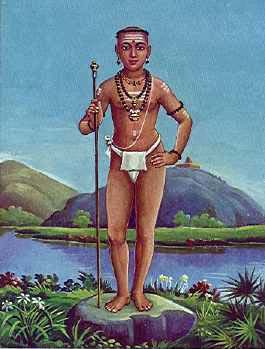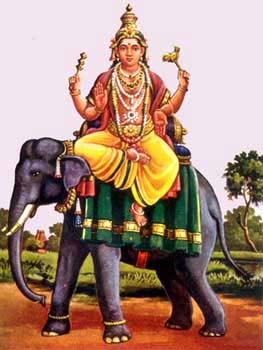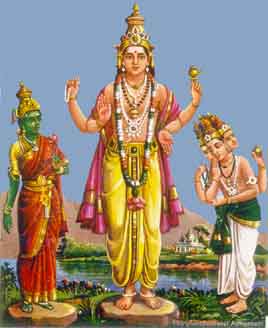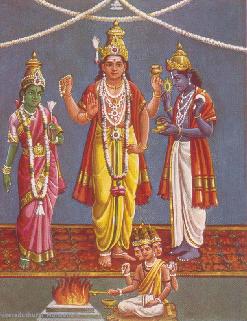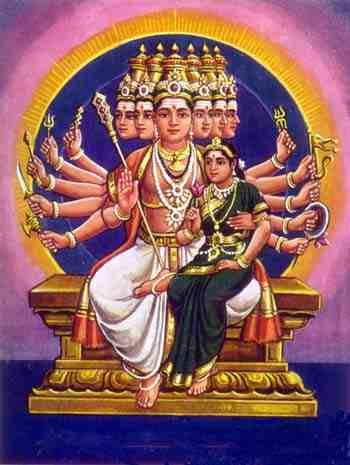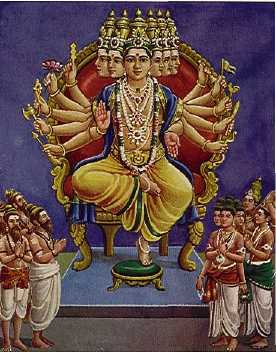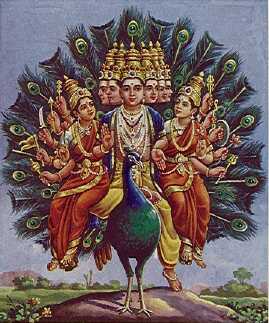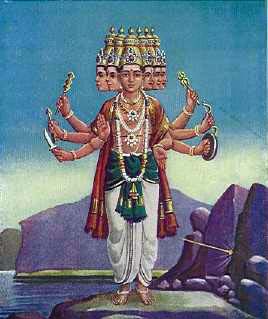
|
||
|
| ||
Significance of Kaumara IconsP. SuyambuHindu IconsHinduism is a dual religious system having both ritual and philosophical schools of thought based upon the human body and soul respectively.1 Rites are the supports for bhakti yoga. ātma vidyā or knowledge of one's self is the central theme of jñāna yoga. Icon worship plays a central role in bhakti yoga. The six major cults (Saivism, Vaisnavism, Śāktam, Kaumāram, Gānapatyam, Sauryam) have their own icons. They believe that their icons are the shadows of their formless all-pervading universal-bodied (vishvasharīra) deity. So devotees give various mythic and philosophical interpretations to their icons. A number of shilpa shāstras (iconographic manuals) describe the various aspects of particular deities, with each deity connected to a particular a myth. From a study of these rituals and myths, one may understand that there is both religious conflict and harmony among the six cults. Kaumara iconsMost scholars opin that Kaumara is a composite cult, including Aryan Skanda and Tamil Murukan cults.2 It is difficult to identify definitely the individual features of each cult. Still one can infer a few features of each from sourcess like iconography and mythology. Sattvic iconsKaumāra icons are classified into three kinds, i.e., sattvic, rajasic and tamasic. When Murukan sits alone with one face and two arms, it is said to be a sattvic image. In this type the right hand of the god holds a lotus or a staff or a śaktivēl (spear). The left hand rests on the waist. Śilparatna says that sattvic images are suitable for worship in the villages.3 These are easily made. Images of Tandapāni4 (of Palani) and Bālasvāmi are of the sattvic type. They are almost nude but for the kaupīna, a small loincloth.5 Staff and vēl (spear) are the weapons of pre-historic man. Worship of vēl has been prevalent in Tamil villages since the Cankam age.6 Ancient Tamilians named their deity as Murukan, which means the embodiment of beauty, wisdom and Supreme power. Thus the cult of Murukan goes back to the pre-historic period.7 The term śaktivēl is a later creation, itself a composite of Sanskrit śakti and Tamil vēl. Rajasic icons:In rajasic images the deity Murukan is seated on a vehicle, a peacock or elephant, with one face and four arms. The lower right hand is in abhaya (protection) pose and the upper hand carry a śaktivēl or a rosary. The lower left hand is in varada (boon-giving) pose and the upper caries either a vajra (thunderbolt) or a kumba (vase) or it will be on his waist. In a few images, the upper right hand carries a sword and the left hands carry a khētaka (shield) and a flag with fowl. Rosary and water vessel are the symbols of Brahmā, the creator. Vajra is the weapon of Indrā. Both were incorporated into Kaumāra symbolism. Devasenāpati, Gajavāhana, Sikhivāhana, Gāngeya, Guha, Brahmāshāsta and Vallikalyānasundara are some rajasic aspects of Skanda. Bālasubrahmanya of Tiruchendur is such a rajasic icon. In this icon, the right upper hand holds śaktivēl and the lower is in varada pose. The left upper hand carries a rosary, and the lower hand is upon his thigh. Skanda is the chief battle god of the Aryan Hindu pantheon. In this role he replaces Indra and Agni.8 Hence Skanda is called Senāpati and Devasenāpati. Gaja (elephant) vahana indicates Skanda as a great warrior riding upon a war elephant. Gāngeya stands on a makara (crocodile). Makara is the symbol of these aspects. It indicates the birth place (river Ganga) of Skanda. In the image of Guha, Skanda has three eyes like Śiva. His consort Devasenā is by his side. The concept of three eyes (one is in forehead) appears to have been adopted from Śiva. Valli Kalyāna Sundara image shows Murukan's marriage to Valli. The upper hands of the god holds a rosary and vase. One lower hand is in abhaya pose and the other is on the waist. Visnu stands with a vessel ready to pour water. Brahmā is sitting with a sacrificial spoon officiating at the ceremony. Murukan is the lord of hill regions. The earliest Tamil grammar Tolkāppiyam and Cankam literature explicitly mention this.9 He married a local hunter chief's adopted daughter Valli. Their marriage is a notable example of the Tamil kalavu (love) tradition. Unlike Devasenā (in Tamil Teyvayānai10) who is imported from the world of Indra's heaven, Valli is an indigenous a child of soil.11 In Tamil the earliest reference to a bride of Murukan is to Valli.12 The Sinhalese also consider Devasenā as an imported wife from India.13 Dravidian icons give Valli a prestigious place, standing on the right of her husband.14 Moreover Valli is the more popular of Murukan's two brides in Tamil areas.15 The marriage of Skanda to Devasenā is largely a symbolic representation, since Devasenā means the army of god personified. Kaumāri, another name of Devasenā, is the feminine form of Kumāra.16 And yet, according to North Indian tradition, Skanda is a bachelor, a brahmācāri. He is the patron of prostitutes since they also never marry.17 BrahmĀshāstā means the teacher of Brahmā. Lord Subrahmanya is also considered to be the god of jñāna (gnosis or wisdom). He once taught the meaning of Pranava mantra (Om) to Brahmā and destroyed the latter's ego and pride. In this aspect Subrahmanya carries rosary and water pot in his upper hands. His lower hands are in varada and abhaya poses. Brahmā is shown with folded palms, reverentially standing by the side of Subrahmanya or he is shown as offering worship to Subrahmanya. This image shows the supremacy of Subrahmanya. Tamasic iconsTamasic images are those which fight with more than four arms, fully terrible armed like śaktivēl, arrow, sword, flag, mace, vajra, khetaka, trident, wheel, conch, staff, plough, or noose, etc. Multiple weapons of Kaumāra icons reveal the supremacy of the deity. To show its god is superior to other gods, Kaumāra theology posits such icons. A myth which is related to this idea is found in Paripātal. In his childhood Lord Murukan conquered the devas' chief, Indra. To honour the child the devas presented one-half of their life in the form of a weapon.18 Then they appointed Murukan as their army chief (Dēva Sēnāpati). This story indicates that Murukan is alone the saviour of the whole universe. Images of Saravanabhava, Sanmukha and Tārakāri have six faces and twelve arms. Tirumurukārruppatai describes the various functions of Sanmukha's faces and hands.19 Murukan or Skanda's birth is connected with these six-faceted images. At least two different birth myths are known. In one, Skanda is the son of Agni. Agni desired the wives of the seven sages but was ashamed of his desire. Then he went to the forest. Svāhā, the daughter of Daksa, was full of desire for Agni. She took the form of each of the sages' wives. She loved six times with Agni. But she was unable to take the form of Arundhati. Six times Svāhā took the form of a garudi bird and deposited the seed of Agni in a golden pot on a white mountain covered with Saravana reeds. From that seed Skanda was born with six faces and one body.20 The second myth explains how Murukan is the son of Lord Śiva. The gods came to see Lord Śiva and asked him for a son to destroy the demon Sūrapadma and save them. Śiva sprouted his five heads and from the third eye of each face a spark issued forth. From their heat the worlds and seas dried up. Umā Devi fled in terror, smashing Her anklets in the process. Śiva told Agni and Vayu to take the sparks and deliver them to the River Ganga. Vayu handed them to Agni, who threw them into the river. Disturbed by the fierce heat, the river carried them on her head to the pond Saravana. From that reedy marsh Murukan arose with one body, six heads and twelve arms, floating on a lotus. Śiva called the Krttikā nymphs to nurse the infant. They beheld six children instead of one. Uma went to the pond and embraced the infants. They merged into one child with six faces and twelve arms. Murukan destroyed the demans Sūrapadma and his brothers Taraka and Singhamukha. He married Valli and Teyvayanai according to the Tamil and Aryan cultures respectively. The second myth has been adopted by many Tamil sources including the Kanta Purānam. Images of Senāpati, Saravanabhava, Sanmukha, Kārttikeya, Tārakāri are related to the above-mentioned myth. In Senāpati and Sanmukha images Valli stands to His right side and Devasenā to his left. Krauñcabheda refers to the myth in which Lord Skanda splits the Krauñca Mountain with his śaktivēl. In this form the Lord has six faces and eight arms. Saurabheya image has four faces and eight arms. But Agnijāta has two faces and eight arms. The Lord engages in offering sacrifice. Dēshika is a one faced image. It has six hands. Two hands exhibit varada pose and one is in abhaya. Two upper hands hold śaktivēl and rosary, one is in cin-mudrā representing 'Om'. Śiva sits cross-legged, with one of his right hands covering his mouth and the other held on the chest in the jñāna mudrā. The upper hands hold deer and battle-axe. Parvati stands by his side. Images of Lord Murukan are full of significance. The two consorts respectively denote volitional and conative cosmic powers of the Lord, while the spear (vēl) indicates supreme knowledge and dynamic power. The soundful cock is the symbol of nāda tattva, while the beautiful peacock represents the bindu tattva. From these tattvas of Suddha Māyā i.e. the primordial pure matter, the whole universe evolved and came into existence. Through volitional power, Lord Murukan blesses devotees with material benefits and joyful thoughts. The conative power bestows celestial life and the cognitive power (vēl) bestows the supreme bliss. The inner meaning of the destruction of the demons is also significant. The souls are enveloped by three impurities (mala): ānava (ego), karma (action) and māyā (bondage). These are represented by Sūrapadma, Tāraka and Sinhamukha. Only after the annihibilation of the impurities with divine grace, the souls become eligible to be freed to enjoy eternal bliss. The destruction of demonic forces by Murukan symbolizes their divine message.21 This interpretation is made on the basis of Saiva Siddhānta. Saivism includes the Kaumāra cult and says Lord Murukan is the incarnation of Śiva. Now Kaumāram has merged with Saivism. End Notes
Bibliography
Dr. P. Suyambu, M.A., Ph.D., teaches Tamil grammar at Aditanar College, Tiruchendur. He has published two books and some sixty papers on traditional grammar and literature. Dr. P. Suyambu
Other articles about Kaumara Iconography and Art History:Karttikeya in ancient Cambodia
Karttikeya in ancient China Skanda in Chinese Buddhism Index of research articles on Skanda-Murukan |

